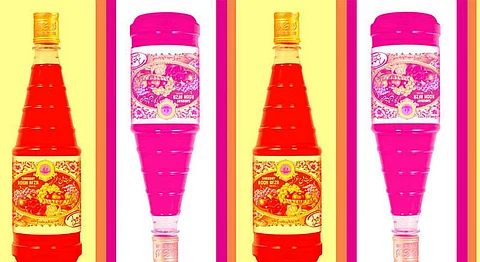
- HOMEGROWN WORLD
- #HGCREATORS
- #HGEXPLORE
- #HGVOICES
- #HGSHOP
- CAREERS
- ABOUT US
- CONTACT US

This Eid marks for a different kind of celebration and resilience amidst these extraordinary times that includes socially distanced and somber festivities. While you engage in wholesome zoom calls with family and friends to keep the eid spirit alive, nothing tops off the sweet relief and joy that a classic rooh afza adds to this occasion. Read on to more about the fascinating history of this much loved drink marked with a rich heritage and character of its own.
Portulaca seeds, chicory, grapes, coriander, and other assorted herbs with sweet odour infused flowers concocts the famous rose drink, found in traditional mixtures, called Sharbat Rooh Afza. Introduced at the time of the British Colonial Rule, Hakeem Abdul Majeed in 1906 created Hamdard which was an Unani Medicine shop in Old Delhi.
Rooh Afza has a history colored by the partition, Hakeem’s elder son stayed in Delhi while his younger son migrated to Pakistan and started the Hamdard business there. Rooh Afza is a staple at the Iftar table with watermelon, stuffed grape leaves, samosas, biryani, and dates.
When Rooh Afza was initially introduced there was no default packaging method. On the Hamdard website, the initial history of the bottle began with ‘Used bottles of wines of any size, colour and shape which could be available were used for syrups.
Rooh Afza is the first sharbat for which white bottles of uniform size (750ml.) and almost of the same shape, Which were called ‘pole ’ bottles, were obtained. The price was obviously very high and they had to be collected in off-season. Rooh Afza is the very first sharbat which was presented in beautifully printed wrapper of butter-paper.’
According to the Hamdard Laboratories Bangladesh website, the name ‘Rooh Afza’ was derived from a character in the book Masnavi Gulzar-e-Nasim By Pandit Deya Shankar Nasim and was first published in 1254. ‘Rooh Afza’ was according to the writer, daughter of the king of Firdaus (Heaven). In Pakistan, Rooh Afza is termed ‘Summer drink of the East’ and is vitally associated with Pakistan’s nationalistic spirit. From it’s inception in 1906 to now, Rooh Afza has also gone through a process of diversification.
Revisiting interests and creating new off-shoots of the classic Rooh Afza is Hamdard’s current approach. A carbonated drink, called Rooh Afza Go was created to update their products, according to the scroll. Rooh Afza was created initially to treat heat strokes and dehydration. In Urdu, Rooh Afza means ‘one that enhances the spirit and uplifts the soul’. The versatility of Rooh Afza is one of the reasons for its incredible popularity.
The scarlet-red syrup is used to make cheesecakes, feerni, custards, milkshakes, ice cream, and even aloo chat. The sherbet drink has many consumers across India and Asia are pining for the taste and are scavenging for more produce since the shortage hit. Homemade Rooh Afza doesn’t compare to the distinctive overpowering flavor of Hamdard’s creations.
The iconic Rooh Afza illustration that covers the front of the slender bottle is the work of Mirza Noor Ahmad. The illustration ‘was therefore printed by special arrangement by the Bolton Press of the Parsees of Bombay. The said artist died only fifteen years back.
It is the same family of artists which has recently succeeded in achieving the composing of Urdu Language through computer’, it says on the official website. The hour of Rooh Afza is now. Hamdard Laboratories have stated that it will resume production as reported by The Mint. Rooh Afza will always be to families across the globe a drink encompassing memories and togetherness through festivities.
If you enjoyed this article, we suggest you read:
